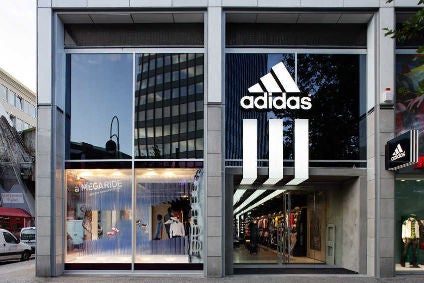
Adidas has suspended all retail and e-commerce operations in Russia.
Reporting its results for the fourth quarter and full-year ended 31 December, Adidas said:
- FY currency-neutral revenues up 16% driven by growth in all markets.
- In Euro terms, revenues increased 15% in 2021 to EUR21.23bn from EUR18.44bn in 2020.
- Net income from continuing operations increased 223% to EUR1.49bn in 2021 from EUR461m in 2020.
- Gross margin increased 0.7 percentage points to 50.7%.
- Currency-neutral revenues in Q4 declined 3%.
- In Euro terms, revenues were flat versus the prior year at EUR5.14bn.
- Net income from continuing operations amounted to EUR123m, compared to EUR143m in the prior-year quarter.
- Gross margin edged down 0.1 percentage points to 49%.
For the year ahead, Adidas expects double-digit topline growth to continue in 2022 amid what it called “heightened uncertainty.” Currency-neutral revenues are projected to increase at a rate between 11-13%. The growth assumption includes a risk of up to EUR250m in the company’s Russia/CIS business – about 50% of Adidas total revenues in the region – due to the war in Ukraine and reflects the suspension of Adidas retail and e-commerce operations in Russia. This amount represents around 1 percentage point of growth for the total company.
- Currency-neutral revenues are expected to increase in all markets.
Gross margin is expected to continue to increase and reach a level of between 51.5-52%. - Net income from continuing operations is projected to increase to a level of between EUR1.8-1.9bn in 2022.
“In 2021, we delivered a strong set of results despite several external factors weighing on both demand and supply throughout the year”, CEO Kasper Rorsted said. “Wherever markets operated without major disruptions we have been experiencing strong top-line momentum. This is reflected in double-digit revenue growth in EMEA, North America and Latin America. While we continued to invest heavily into our brand, our direct-to-consumer business, and our digital transformation, we improved our bottom-line by more than EUR1bn. Taking it all together, 2021 was a successful first year within our new strategic cycle. In 2022, we will build on this momentum and continue to grow both our top- and bottom-line at double-digit rates amid heightened uncertainty.”
Commenting on the numbers, Darcey Jupp, apparel analyst at GlobalData, a leading data and analytics company, says while Adidas closed FY2021 up a healthy 15.2% to EUR21.2bn, it stopped short of being a year of resurgence for the brand.
“Despite sportswear continuing to be in high demand, Adidas struggled against the weight of numerous external influences, including supply chain issues and lockdowns, and failed to fully recover sales lost in FY2020, finishing the year 1.3% down on FY2019. Adidas’ Q4 performance was particularly damaging to its full-year sales. As predicted, its supply chain problems first acknowledged in Q3 were heightened, and the North American business felt the most strain with the region accounting for roughly half of lost revenue. Adidas estimates it lost over EUR400m as a result of this, in combination with its challenges in Greater China and lockdowns in Asia-Pacific.

US Tariffs are shifting - will you react or anticipate?
Don’t let policy changes catch you off guard. Stay proactive with real-time data and expert analysis.
By GlobalData“As a sportswear brand, Adidas felt the full force of the supply chain crisis as its products are heavily branded, and consumers often want specific items, so will wait to purchase instead of choosing a similar product. The peak of the supply chain crisis coinciding with the golden quarter was particularly damaging to Adidas, as sportswear is a popular Christmas gift. However, Adidas has been able to mitigate some damage with its direct-to-consumer push, reporting double-digit growth for the full year. While this strategy cushioned the loss of revenue in Q4 FY2021, the brand should be cautious of its long-term impact, as it must keep a high level of brand visibility to protect its weak toplines.
“Of its regions, EMEA saw the biggest uplift in revenue, with full year sales 24% higher on a currency-neutral basis as it benefitted from weak comparatives in a high-consumption sportswear market. However, as uncertainty looms in Europe amidst the Russia-Ukraine conflict, Adidas is already bracing itself for the hit to its Russia/CIS business, estimating that up to EUR250m of sales could be at risk in FY2022 – roughly 50% of revenue in the region. The brand has joined other global apparel players in withdrawing its in-store and online operations in the Russian market, alongside ending its partnership with the Russian Football Union. Additionally, Adidas faced further troubles in Greater China. Despite focusing on the Chinese market as part of its new ‘Own the Game’ strategy, Adidas has struggled as a result of strict Covid measures and a boycott after it raised concerns about alleged human rights violations of Uyghurs in the Xinjiang region, with full year sales increasing just 3.0% on a currency-neutral basis.
“To achieve its FY2022 outlook of currency-neutral growth between 11-13%, Adidas must strengthen its brand identity. Its collaborations have always been a successful part of its repertoire, and after already announcing collections with Gucci, Beyoncé’s Ivy Park, and Prada to be released this year, this could be the brand’s saving grace. Collaborations build hype and excitement, which is the attention Adidas needs to stay competitive against its rivals. Its successful ventures into the metaverse will also help boost the brand name among digitally-savvy younger consumers and shows its dedication to virtual innovation, with this market expected to grow considerably in the near future.”



